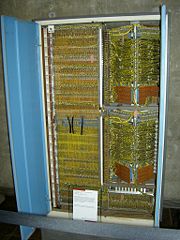
IBM 7040
Encyclopedia
The IBM 7040 was a historic but short-lived model of transistor computer
built in the 1960s.
 It was announced by IBM in December 1961, but did not ship until April, 1963. A later member of the IBM 700/7000 series of scientific computers, it was a scaled down version of the IBM 7090
It was announced by IBM in December 1961, but did not ship until April, 1963. A later member of the IBM 700/7000 series of scientific computers, it was a scaled down version of the IBM 7090
. It was not fully compatible with the 7090. Some 7090 features, including index registers, character instructions and floating point, were extra-cost options. It also featured a different input/output architecture, based on the IBM 1414 data synchronizer, allowing more modern IBM peripherals to be used. A model designed to be compatible with the 7040 with more performance was announced as the 7044 at the same time.
Peter Fagg headed the development of the 7040 under executive Bob O. Evans
.
A number of IBM 7040 and 7044 computers were shipped, but it was quickly made obsolete by the IBM System/360 family announcement in 1964. The schedule delays caused by IBM's multiple incompatible architectures provided motivation for the unified System/360 family.
The 7040 proved popular for use at universities, due to its comparatively low price. For example, one was installed installed in May 1965 at Columbia University
.
One of the first in Canada was at the University of Waterloo
, bought by professor J. Wesley Graham . A team of students was frustrated with the slow performance of the Fortran
compiler. In the summer of 1965 they wrote the WATFOR compiler for their 7040, which became popular with many newly formed computer science departments.
IBM also configured the 7040 (or 7044) as an input-output processor attached to a 7090, in a configuration known as a directly coupled multiprocessing system. Each computer was slightly modified to be able to interrupt the other.
IBM used similar numbers for a model of its eServer pSeries 690 RS6000 architecture much later. The 7040-681, for example, was withdrawn in 2005.
Transistor computer
A transistor computer is a computer which uses discrete transistors instead of vacuum tubes. The "first generation" of electronic computers used vacuum tubes, which generated large amounts of heat, were bulky, and were unreliable. A "second generation" of computers, through the late 1950s and...
built in the 1960s.

IBM 7090
The IBM 7090 was a second-generation transistorized version of the earlier IBM 709 vacuum tube mainframe computers and was designed for "large-scale scientific and technological applications". The 7090 was the third member of the IBM 700/7000 series scientific computers. The first 7090 installation...
. It was not fully compatible with the 7090. Some 7090 features, including index registers, character instructions and floating point, were extra-cost options. It also featured a different input/output architecture, based on the IBM 1414 data synchronizer, allowing more modern IBM peripherals to be used. A model designed to be compatible with the 7040 with more performance was announced as the 7044 at the same time.
Peter Fagg headed the development of the 7040 under executive Bob O. Evans
Bob O. Evans
Bob Overton Evans , also known as "Boe" Evans, was a computer pioneer and corporate executive at IBM . He led the groundbreaking development of compatible computers that changed the industry.-Early life and education:Evans was born in Grand Island, Nebraska...
.
A number of IBM 7040 and 7044 computers were shipped, but it was quickly made obsolete by the IBM System/360 family announcement in 1964. The schedule delays caused by IBM's multiple incompatible architectures provided motivation for the unified System/360 family.
The 7040 proved popular for use at universities, due to its comparatively low price. For example, one was installed installed in May 1965 at Columbia University
Columbia University
Columbia University in the City of New York is a private, Ivy League university in Manhattan, New York City. Columbia is the oldest institution of higher learning in the state of New York, the fifth oldest in the United States, and one of the country's nine Colonial Colleges founded before the...
.
One of the first in Canada was at the University of Waterloo
University of Waterloo
The University of Waterloo is a comprehensive public university in the city of Waterloo, Ontario, Canada. The school was founded in 1957 by Drs. Gerry Hagey and Ira G. Needles, and has since grown to an institution of more than 30,000 students, faculty, and staff...
, bought by professor J. Wesley Graham . A team of students was frustrated with the slow performance of the Fortran
Fortran
Fortran is a general-purpose, procedural, imperative programming language that is especially suited to numeric computation and scientific computing...
compiler. In the summer of 1965 they wrote the WATFOR compiler for their 7040, which became popular with many newly formed computer science departments.
IBM also configured the 7040 (or 7044) as an input-output processor attached to a 7090, in a configuration known as a directly coupled multiprocessing system. Each computer was slightly modified to be able to interrupt the other.
IBM used similar numbers for a model of its eServer pSeries 690 RS6000 architecture much later. The 7040-681, for example, was withdrawn in 2005.

